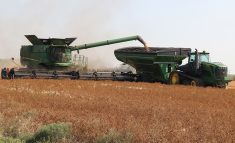It’s the middle of May, and in west-central Saskatchewan, we have barely started seeding. The wintry weather is increasing the frustration, and along with this comes the panic about getting all the kernels in the ground soon enough to allow for an adequate maturing process.
Often at this time of year, friends and relatives come to help get the seeding done. This help is much appreciated, but with the extra help comes the worry of safety. Because of the lack of experience, familiarity, and ages of some of the farm helpers, accidents are more likely to happen at this time. With the shorter season this year, added stress will increase the risk of accidents.
Read Also

Support needed at all levels for high-value solar projects
Farmers, rural municipalities and governments should welcome any opportunity to get involved in large-scale solar power installations, say agrivoltaics proponents.
The Saskatchewan Farm Safety Program of the provincial labor department has many statistics of farm fatalities and accidents. Program representatives have been visiting rural schools since 1987 increasing the awareness of farm safety practices among Saskatchewan’s youth.
For more information, phone
1-800-567-7233 or 306-787-8399, fax: 306-787-2208. In each province, the local department of agriculture or agricultural representative office will have farm safety
information.
Farm statistics
- Forty-three percent of accidental deaths on Saskatchewan farms from 1983-1994 involved machinery, mainly tractors.
- Of the farm fatalities involving tractors, 53 percent were runovers, 31 percent were rollovers and 16 percent were PTO-related.
nAugers were the next most dangerous piece of equipment, with 80 percent of auger fatalities involving electrocution.
- July and September show more fatal accidents. (School-age children are home for the summer when haying and harvesting get in full swing.)
- The age of farm fatality victims varies: 30 percent were over 60 years; 27 percent were 40-59 years; 20 percent were 20-39 years; 23 percent were under 20 years.
The highest percentage of deaths occurs with people over 40 years old. The average age of farmers is around 50 years old.
nOn average, each year one quarter of the accidental deaths occurring on farms involve children. Most at risk are children under age five and those in their early teens. There were more deaths of male children (81 percent) than female children. In the under-five years, however, girls are involved in 30 percent of farm accidents which result in death.
- The six most common causes of fatal farm accidents involving children up to age 19 are machinery and vehicles, drowning (in water or in grain), recreational vehicles, livestock, fire and farm chemicals.
These statistics are alarming. The best way to keep children safe is by example, education and prevention.
For children one to five years old:
nKeep them physically away from farm hazards.
- Create or designate a safe play area and teach them the rest of the yard is out-of-bounds. Restricted areas are machinery, dugouts, bins, corrals and the shop.
- Never allow extra riders. Always follow the rule “no seat, no rider.”
For ages six to 12 years:
- Teach them to recognize and identify farm hazards.
- Continue to teach children the best way to stay safe is to stay away from hazards.
- As they get older and start to operate small equipment (eg. lawnmowers), teach them to think ahead to try to prevent accidents.
- Teach them early how to shut off equipment. This could save a loved one’s life.
- Remember that physical maturity does not correlate to mental maturity.
For 13 to 18 year olds:
- Allow them to operate machinery only after thorough training and supervision are provided.
- Keep in mind the teenager’s level of maturity and lack of experience.
- Be aware you are the role model.
- Encourage family members to take first aid and CPR training.
- Review safety procedures annually, with hired help and family members.
- When driving equipment, use alternate approach ways to the farmyard, rather than coming by the house and the children.
- Stay alert and learn to manage stress.
Raising happy, healthy kids on farms involves making many tough decisions, especially when it comes to machinery or vehicle operation. No matter what you decide as parents, make decisions you and your family can live with – safely.
Recipes wanted
Dear TEAM: I have enjoyed your recipes from this column and was wondering if you would have the recipe for the Clausean pickles?
– F.B., Meath Park, Sask.
Can any readers help us with this, please?
Dear TEAM: We appreciate The Western Producer, and have used a lot of the ideas and recipes. We would appreciate a recipe for making candied ginger as we eat it as a candy and cook with it. – M.J. and A.J., Sylvan Lake, Alta.
In response to M.H.’s request for a soft oatmeal cookie recipe similar to the Voortman cookies, S.H. from Glenbush, Sask. sent in the following recipe:
Jam turnovers
1 cup margarine 250 mL
1 cup brown sugar 250 mL
1Ú2 cup white sugar 125 mL
6 tablespoons syrup 90 mL
1 cup coconut 250 mL
11Ú2 cups oatmeal 375 mL
3 cups flour (or 750 mL
more)
1 teaspoon baking 5 mL
soda
1 teaspoon baking 5 mL powder
3 eggs 3
1Ú2 teaspoon salt 2 mL
1 teaspoon vanilla 5 mL
Cream together margarine, sugars and syrup. Add beaten eggs and vanilla. Stir well. Put coconut and oatmeal in blender and chop about 30 seconds (not too fine). Add to batter. Stir in flour, salt, baking soda and baking powder. Mix well. Dough should be quite soft and a bit sticky. Roll out on a well-floured surface to about 1Ú8 inch (two cm) thickness.
Cut with a large round cookie cutter. Place a teaspoon of jam on the centre of each cookie and fold over (no need to pinch centres). Place well spaced on a cookie sheet. Bake 12 to 15 minutes in a 350 F (180 C) oven.
S.W., of Winnipeg, Man., called requesting “Grasshopper” dessert recipes that have creme de menthe and green food coloring. This Grasshopper Pie recipe, also known as Creme de Menthe Pie, is baked in a chocolate cookie crust and tastes minty and delicious.
Grasshopper pie
Chocolate cookie crust:
1Ú3 cup butter or 75 mL
margarine
11Ú4 cups chocolate 275 mL
wafer crumbs
Melt butter in saucepan. Stir in chocolate crumbs. Reserve two tablespoons (30 mL). Press remaining crumbs onto bottom and sides of nine-inch (22-cm) pie plate. Chill.
Filling:
1Ú2 cup milk 125 mL
24 large 24
marshmallows
1Ú4 cup creme de 50 mL
menthe, green
2 tablespoons creme 30 mL
de cacao, clear
1 cup whipping 250 mL
cream (one envelope topping)
Heat milk in large heavy saucepan. Add marshmallows and stir until melted. Cool. Stir in creme de menthe and creme de cacao.
Beat cream in small bowl until stiff. Fold into marshmallow mixture. Turn into pie shell. Sprinkle with reserved crumbs. Chill.
Note: If you prefer, you may omit liqueurs and add a few drops of peppermint flavoring to taste, along with a bit of green food coloring. Add extra milk in place of liqueur.
Taken from PIES – Company’s Coming by Jean Pare, Company’s Coming Publishing Limited, Box 8037, Station F, Edmonton, Alta., T6H 4N9.















